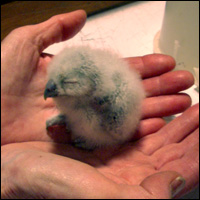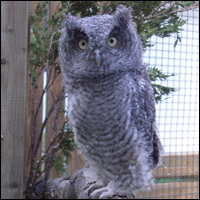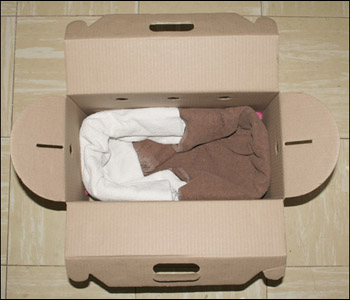|
If you or someone you
know has found an injured or otherwise distressed raptor, it is of utmost
importance to get in touch with and transfer the animal to a licensed
wildlife rehabiliator as soon as possible. This is in the very best
interests of any wildlife you find and can mean the difference between
life and death.
Please do not attempt
rehabilitation of wildlife on your own. Communication with experienced,
licensed rehabilitators is key to providing the best care for sick,
injured or orphaned wildlife. Licensed rehabilitators have been specially
trained for triage, convalescence and paliative care of wild animals.
Most provinces of Canada
allow their citizens to hold onto wildlife for a maximum of 24 hours
at which time the wildlife must be released or transferred to an authorized
wildlife rehabilitator. It is illegal to maintain wildlife beyond this
24 hour limit without special permitting from the Ministry of Natural
Resources. These regulations have been set in place to protect our native
wildlife from typically well-meaning, but inexperienced people. Animals,
especially those injured, sick or orphaned, require special care and
medical needs that most people are unable, unwilling or too niave to
provide properly.
If you have found a raptor
in distress, please visit the Wildlife
International page for listings of rehabilitators in your area.
You may also contact your local Humane Society or Ministry of Natural
Resource office for information.
DO
NOT FEED OR GIVE WATER TO ANY RAPTOR WITHOUT INSTRUCTION BY AN
EXPERIENCED REHABILITATOR.
You can be doing more harm than good. Raptor
throat anatomy is very different from yours.
You can drown a raptor by putting fluids and food into the wrong
area. |
Initial Assessment
of Found Raptors:
Young
Birds
Young owls fledge from their nests before they are capable of sustained
flight. They follow their parents by hopping from branch to branch and
flying short distances. Sometimes these youngsters find their way to
the ground. Here their parents usually will not feed them, though they
always have a watchful eye on their chicks. Being grounded can lead
to any number of problems including animal attacks (cats, dogs, crows,
raccoons etc...), emaciation, maggot infectations and collisions (cars).
As a first resort, attempt to place the bird onto a branch, or onto
a ledge where it can safely sit off the ground. Sometimes youngsters
simply cannot find a method of getting up off the ground themselves.
This procedure is only useful for fledglings. Alternatively, a man-made
nest can be erected on a tree and the chick placed on/in it. This is
especially useful when the nest tree has been cut down. If the chick(s)
cries, the adult will return. Adult owls will not necessarily return
until dusk.
Nestlings need to be
returned to their nests or transferred to a rehabilitator. For nest
return, you must be capable of distinguishing between owl nests and
those of other birds. This requires a knowledge of species breeding
methods and tends to be difficult to do successfully (some are cavity
nesters). For instance, Great Horned Owl nests are usually easily found
(old Red-tailed Hawk nest made of sticks) but can be tough to access
and dangerous to approach (Great Horned Owls will protect their nests
by force). Sometimes climbing up to a nest will promote the "early
fledging" of a second chick that results in you being back to square
one. Provision of a man-made nest nearby will often work for older nestlings
and branchers. Young nestlings cannot thermoregulate on their own and
must be constantly tended to and warmed by their mother. As a result,
providing a second nest site for a young nestling(s) will only work
if the female has abandoned her original nest (e.g. nest tree was cut
down). Otherwise, she cannot tend to two sets of nestlings. Due to these
scenarios and "what ifs", it is usually in a nestling's best
interest that it be taken to a rehabilitator who can work to return
the chick to its parents safely or raise the bird in an appropriate
environment with appropriate stimulae for future release.
|
|
Young
Nestling Screech Owl |
Fledgling
Screech Owl |
| Most
raptors, including owls, hawks and falcons, require surrogate parents
of their own species to be raised successfully for release back
to the wild. They also must learn to hunt live, natural-type prey.
It is very important to get an orphaned chick to an experienced
rehabber ASAP. Waiting even a few days will lead to nutritional
deficiencies and irreversible psychological damage (human imprinting).
Improper housing can lead to feather damage which can take several
years to remedy. |
Baby owls are very cute balls of fluff and can be very accomodating
and fun to have around.
Don't get sucked in!
These little guys need their parents, not humans. They should
never be coddled, petted or passed around. This is stressful and
inappropriate. They are wild animals who need to stay wild for
successful release back to nature.
Owls are not pets.
|
Sick and Injured Birds
If the bird you have found is showing signs of sickness or injury such
as difficulty breathing, bleeding, stumbling, fractures or other trauma,
the animal will require immediate medical attention. If you have trouble
finding a local rehabilitator, consider contacting your local veterinarian.
Many veterinarians can do simple, cheap procedures such as wing wrapping,
pain relief and fluid therapy until a rehabilitator can be contacted.
Temporary Housing
for Transport to a Rehabilitator:
You
Will Need
Cardboard box with lid
Pen or Boxcutter
Towel or other soft cloth
Work gloves
Find a cardboard
box approximately half again as long as the bird and twice as wide.
The bird should be able to sit upright in the box without bumping
its head against the top. The box should not be
so large as to allow the bird to walk around. The idea is to keep
the bird contained in one spot, but as comfortable as possible.
If the box is too big the bird can hurt itself as it fights to escape.
Broken wings can be rotated improperly and blood circulation can
be cut off.
Prepare the box by punching holes from the inside out along all
walls approximately 2/3 of the way up. This will allow ventilation
for the bird to breathe while it remains in the box. You don't have
to go overboard. Five - ten holes per side, depending on the size
of the box, is enough. If you have access to a boxcutter, you can
cut one inch holes 2/3 of the way up from the inside out (two -
three per side).
Place a towel or blanket in the
bottom of the box. This provides cushioning, warmth and gripping
substrate for the animal.
|
|
Catching
the Bird
In most cases an orphaned, sick or injured raptor will be fairly
easy to contain by simply picking it up. It is helpful to throw a towel
or blanket over the bird as you approach. Scoop the animal and towel
up together. The bird should grab the towel, not you. It is suggested
that you have a pair of work gloves with you as well since raptors will
often use their last bit of strength to protect themselves. Do not leave
the towel over the bird once it is contained in the box.
If the bird is capable of walking just a touch too fast to capture single-handedly,
ask a friend to help corral the animal into a corner or directly into
the box (put the box on its side on the ground).
If the bird cannot sit up in the box, use a second towel to encircle
its body and prop its head onto the higher surface like a pillow. This
will also keep the bird from falling over during transport.
Keep the box covered (either with a lid or blanket) as raptors have
a tendancy to escape.
Maintain the box/bird
in a dark area at room temperature (~22ºC/70ºF). Keep the
bird from stressful stimulae such as noise, children, pets and television.
A stressed hawk will freeze and stare with mouth gaping and wings out,
if capable. Owls can display stress in many ways including playing dead,
snapping their beaks, hissing and fluffing up. Raptors can pant if stressed.
Many scared raptors will show defense tactics such as lunging with their
beaks or grabbing with their feet. Be careful.
During transport, do not play music and keep talking to a minimum. Keep
an ambient temperature in the vehicle and try to place the box in an
area that will not receive direct sunlight.
The rehabilitator you contact will give you further instructions geared
toward the species and injury you are dealing with.
The instructions above are for short-term care only. Emaciated birds
and those with injuries require immediate medical attention. You will
not find information on long-term housing of raptors on this website,
including proper dietary requirements. This is best left to licensed
rehabilitators.
|


